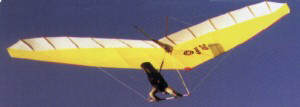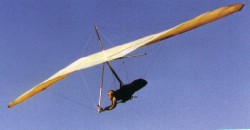Avian Rio
by Gary Hulme from [Skywings],
April 2000

Build
I'd already discovered that the Rio was pretty
light and quick and easy to rig. It came in at 601b carry-up weight,
including the padding and my XC bag. The build quality is excellent,
especially bearing in mind the competitive price, and is equal to
any of the hot ships on the market.
The test glider came with all the trimmings:
a white, scrim mylar leading edge, rubber
backed aerofoil uprights and a removable
rear keel for power flying. Even for a
low airtime pilot I would recommend the mylar
leading edge, speedbar and aerofoil uprights. The
mylar will keep clean and good looking for far longer
then dace on, gives slightly better performance and
looks really sexy (what a tart!), and the aerofoil uprights
sit on the shoulders more comfortably when ground
handling.
The airframe is pretty conventional and the
quality of engineering high. If small details such as the holes
in formed battens each side, two
straight undersurface battens and two
tip battens. There are no wingtip
washout rods. The cross tubes
are joined by a very neat channel and
butt together flush when tensioned for
maximum column strength. The only (tiny)
guzzles I had with the fast and easy rigging procedure
are that the nose batten is pretty hard to seat
on its rivet and, if rigging on the A-frame, attaching
the tuff -line bridle to the kingpost takes a bit
of pulling to bend the keel. Rigging flat, attaching the
tuff-line bridle is very easy. The sail
is well made from very high quality sailcloth, with simple and practical
double bungees securing the battens, The glider really looked the
part, with its shiny white mylar leading edge and lilac undersurface,
Neat proper sail ties are used (Icaro and Wills Wing please
take note)
 In
the Air
In
the Air
Flying the glider proved 'it does what it says
on the tin'. Static balance is slightly tail heavy but easy enough
on the shoulders, due to its light weight and well mannered ground
handling. My first take-off, from a very shallow slope in an I 8mph
wind, gave a small surprise. I went up more quickly than expected
and was also penetrating more slowly - the true wind was probably
22mph + above take-off. Further flights demonstrated very easy take
off characteristics -lust beware of assuming it can handle really
strong winds like a tweaked topless monster In strong winds, more
strength is required to hold it
Recent letters in Skywings have recently been
highlighting the apparently relentless decline of hang gliding.
Gliders, it is suggested, have become too expensive, heavy, complex
and difficult to land for recreational pilots. Skyfloaters have
had a positive impact, but their appeal has been limited with sonic
buyers due to their rather `unsexy' image. They are regarded by
some as rather baggy and slow, lacking the into-wind penetration
performance to attract paraglider pilots wanting a windy-weather
alternative, or more experienced hang glider pilots looking for
an all round replacement for their ageing hot-ship.
The Rio is Asian's take on an alternative approach
- a sports glider (or Intel mediate to give it its less glamorous
title) that is faster than a skyfloater, lighter and easier to fly
than a typical kingposted CFX glider. 1 collected the test Rio,
a shiny, brand-new and unflown model from the Telford show. As an
aside, aren't most of the punters and the traders (yes, Including
me) getting old! We need to attract new and younger blood to keep
each flight vibrant and growing.
Testing plans included trying the Doodlebug
with the Rio -the glider has also been developed with auxiliary
power flying in mind. However, testing gliders in our glorious winter
weather r-requires patience - oh the joys of rigging a glider for
the third consecutive time and not flying - due to believing Wendy
and Mr. Fish',,; fairy stories. Sadly the Doodlebug test was not
to he, as the glider had to he returned before I could travel south
to Ben Ashman,,; airfield to be trained in its use.
Patience was eventually rewarded alter nearly
six weeks of waiting, with some superb, smooth flying in ridge,
light thermal and wave conditions. 1 ignored the rubbish that Wendy
and the Met office offered and went with local knowledge and gut
feel - the Cumbrian mountains don't always behave as per the textbooks
on weather.
Roll control was a very pleasant surprise. Very
light, predictable and easy to reverse. Just what a beginner or
jaded old hack like me needs. In fact I would go so far as to say
this is the best handling CFX glider I've flown in terms of roll.
Easy to 360, I tried some mild wingovers to about 80° angle of bank
- naughty and yes, I know, outside the placarded envelope but fun
in silk-smooth winter wave whilst watching the setting sun's red
glow play on the wave-sculpted cloud lust below me... There are
some benefits in living in the land of monster carry ups!
Pitch is light and positive around min, sink.
Pushing out, the glider slows but doesn't want to stall. If crone
slowly and Progressively the wing will
when your arms are nearly fully outstretched.
Height loss is minimal and it remains controllable right up to the
break. These characteristics are very beginner friendly and predictable.
You'd need to be a heavy-handed klutz to inadvertently stall this
glider in smooth air Please don't try this near the ground or on
a turbulent day though!
Pulling speed, the wing quickly accelerates
- forwards then, above 30mph indicated airspeed, down, though with
a better glide than say a skyfloater and considerably safer turbulent-air
penetration than a paraglider when near the ground. Performance
is excellent for its class but care needs to be exercised if you
see the hot ships flying on very windy days
when the fastest Paragliders and a skyfloater
had given up; the Rio is fine in any 'sensible' conditions.
With the bar to my knees, pitch went rather
light if speed was aggressively pulled on, before 'biting' and feeling
more positive. Even at 50mph the sail stayed quiet and directional
stability was excellent throughout. Forward progress was fairly
limited at these excessive speeds and bleeding off speed in level
flight to penetrate did not really work either - the energy retention
is too low. Again these are good characteristics for a low airtime
pilot - no inadvertent zoom climbs if landing a little fast into
a small field.
Landings themselves are very easy. The flare
window gently on to your shoulders without
the drama and the high heartbeat associated with landing even 'ordinary'
5th-generation machines, let alone some topless models. Even a 'fluffed'
nil-wind top landing at Wether Fell was easy to handle. Overshooting
my planned landing area (the wind dropped from 15mph to almost nothing
in the last 50ft) I simply ran off the 'step' at the front of the
landing area and easily and neatly landed on a lower area five feet
below, with a gentle non-critical flare. Mmmm, nice! as the man
on the Fast Show is fond of saying.
Conclusion
The Rio is a fully sorted, delightful glider
It is far superior to older intermediates such as the Airwave Calypso,
Aerial Arts Clubman, etc. As for choosing an older 5th-generation
model - sold with utter lies in many private adverts as 'good intermediate
glider/suitable for low airtime pilots '- don't do it! Magic
Ills and IVs, Aces, Rumours, etc, are a terrible choice for fledgling
pilots and should be avoided at all costs, until you've got at 80
-100 hours under your belt.
It has perhaps lust a little too much performance
for 'less natural' new pilots straight from school, who may have
to fly small and crowded sites or perhaps only fly occasionally;
a skyfloater may be better in this instance. More confident pilots
may lust want to be converted by their school and go straight on
to the Rio. If you are tow based - go for it: on a flat field and
under the school's supervision a new pilot should find it lust perfect.
It is good, I'm told, on the winch, aerotowing or with an auxiliary
power unit, but time and weather constraints precluded trying these
options for myself.
So there you have it - a damn fine machine that
will keep most pilots happy. Longtime fliers used to more
performance may want lust a bit more and will
definitely yearn for a long travel VB. Regardless, if you want a
sweet-handling, forgiving-to-land glider, which has great XC potential
and is easy to fly, even if you are not current .... buy one and
have fun!
Manufacturers Comment
Currently we produce the Rio in one size - 15
square meters sail area. This is for a (naked) pilot weight range
of 8 - 13 stone and would suit the majority of pilots. We have had
enquiries for both a larger and smaller version of the Rio. We are
keen to try and gauge the likely demand before manufacturing these
other sizes due to the development costs involved. If you are interested
in a larger or smaller Rio (or even a l5 sq/m one!) please let us
know.
STEVE ELKINS, AVIAN HANG GLIDERS
Specification
Wingspan (m) 9.5
Wing area (m') 15
Aspect ratio 6:1
Nose angle 120°
Percentage double surface
55%
Normal packed length (m)
5.6
Short-packed length (m)
3.8
rigged weight (kg)
25.3
Weight including bag (kg)
27.4
Speed range (mph)
15 - 55.
Naked pilot weight range (kg)
51 - 83`
Pilot clip-in weight range (Kg)
61 - 91
Maximum clip-in weight with power (Kg)
110
Certification BHPA Certification to follow.
UK price inc VAT £2,399